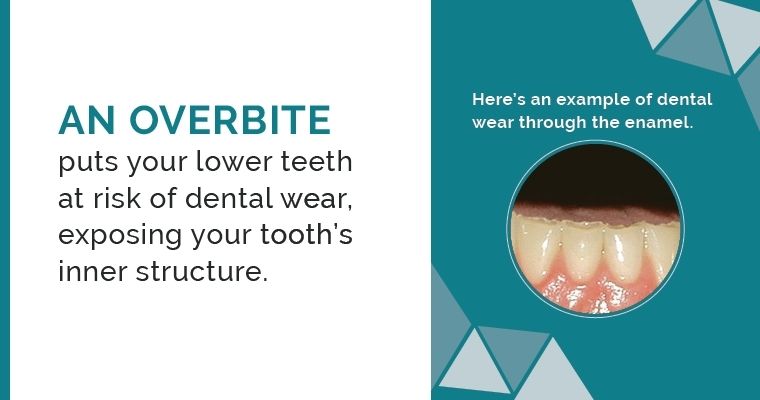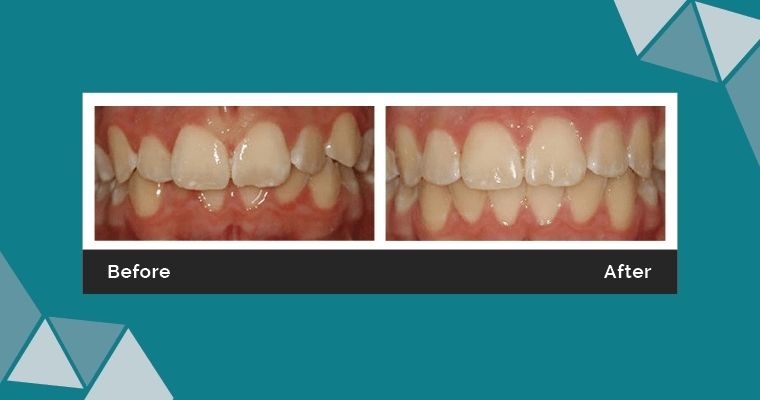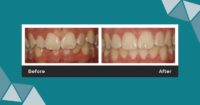Orthodontics has an incredible power to correct many issues with your teeth and bite, including:
- Deep overbite
- Underbite
- Overcrowding teeth
- Crossbite
- Open bite
- Gapped teeth
So, how does orthodontics fix each of these issues?
Well:
In this blog, we’re going to focus on how to fix a deep overbite, including:
Ready? Let’s get started.
What are deep overbites?

This gets confusing because most folks refer to overbite as the degree to which the upper front teeth extend in front of the lower front teeth. Orthodontists refer to that as “overjet.”
Notice how the upper tooth gets thicker the higher up you go?
This becomes a problem when the more delicate biting edge of the lower tooth strikes the thicker part of the upper tooth.
Over time this results in wear of the lower front teeth, and it’s common for folks to wear through the tough enamel, exposing the softer inner structure of the tooth known as dentin.
Once dentin is exposed, the rate of tooth wear can increase. The bottom line is that deep overbites raise the risk of dental wear.

How are deep overbites corrected?
Deep overbites can be corrected with either braces, removable appliances, or both.
With braces, the upper and lower teeth are moved away from each other. People often ask if the teeth are buried in the gums.
The answer:
The gums and underlying bone move with the teeth. In the end, the teeth don’t lose their length.
The most typical removable appliance is known as a biteplate, pictured below:
The way biteplates work is that when worn, the patient’s lower front teeth bite into the front plastic part of the biteplate, and that keeps the patient from biting down too deeply.
The back teeth, or molars, are no longer in contact.
Teeth tend to erupt until they meet something, so when a biteplate is worn and the molars aren’t touching, they tend to erupt or grow toward each other.
Eventually, the molars will meet sooner, and the patient doesn’t close as far, so the front teeth don’t overlap as much.
The orthodontist will determine which method of treatment will work best for each individual patient, based upon proper diagnosis of the underlying cause.
How does it look once a deep overbite is treated?

Notice where the front teeth are sitting? They’re no longer at risk of wear and tear from the lower teeth.
Are you experiencing tooth sensitivity or pain?
This could be a sign of your dentin being exposed, which could be the cause of a deep overbite.
On top of that:
If you’re unhappy with how your smile looks, schedule a consultation and let’s examine your smile.
As a Bellevue orthodontist, Dr. Jeffery Schur has made it his mission to help patients reach their full potential in oral health and appearance.
And with a consultation, he’ll do a thorough examination of your bite and smile to determine:
- The cause of any painful symptoms you’re experiencing (including if you have a deep overbite)
- What steps to take to help you get out of pain and straighten your smile
- Help you coordinate with other healthcare providers to ensure treatment is properly sequenced and coordinated
Fill out the form below to get started:
*We promise to never sell your information.
Or:
- Call us: (425) 747-4477
- Email us: info@schurorthodontics.com
Schur Orthodontics is located in Bellevue, WA… This text opens a new tab to our Google listing…, and sees patients from all over the area, including Redmond, Kirkland, Seattle, Renton, Eastside, and Woodinville.
Editor’s note: This post was originally published in January 2016 and has been completely revamped for comprehensiveness and timeliness.



